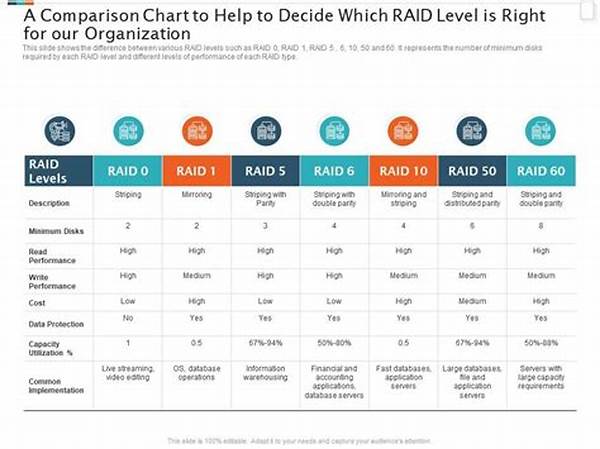High-performance computing (HPC) demands robust and efficient data storage solutions. One such solution comes in the form of RAID (Redundant Array of Independent Disks) configurations. By comparing RAID levels for HPC systems, one can optimize data storage to balance performance, redundancy, and cost. This article explores some critical aspects of RAID solutions, illustrating their relevance to HPC environments.
Read Now : Code Profiling And Analysis Tools
Understanding RAID Levels for HPC Performance
RAID technology offers a myriad of configurations to cater to different performance, capacity, and redundancy needs in HPC systems. RAID levels, each with distinct attributes, can dramatically influence system performance and reliability, crucial for high-performance computing applications. By comparing RAID levels for HPC, we identify configurations that optimize read/write speeds while safeguarding against data loss.
RAID 0, known for striping data across multiple disks, offers enhanced performance but lacks redundancy. Conversely, RAID 1 improves redundancy by mirroring data across disks, thus providing fault tolerance at the expense of storage efficiency. RAID 5, a popular choice, strikes a balance by distributing parity along with striping, enhancing both speed and fault tolerance.
RAID 6 takes it further by adding an extra parity block, suitable for systems requiring high data protection. RAID 10 combines RAID 0 and RAID 1, delivering excellent performance and redundancy but at a higher cost of resources. Comparing RAID levels for HPC environments involves assessing these trade-offs to select the most efficient configuration for specific computational needs.
Key RAID Level Characteristics
1. RAID 0: Offers maximum performance by striping data but lacks fault tolerance. When comparing RAID levels for HPC, it’s ideal for high-speed access but not for sensitive data.
2. RAID 1: Mirrors data, ensuring reliability. Comparing RAID levels for HPC emphasizes RAID 1 for critical applications despite reduced storage efficiency.
3. RAID 5: A balance of performance and redundancy with distributed parity. In the context of comparing RAID levels for HPC, it offers a practical solution for many applications.
4. RAID 6: Provides stronger fault tolerance with additional parity. When comparing RAID levels for HPC needs, it’s favored for environments requiring robust data protection.
5. RAID 10: Combines performance and redundancy of RAID 0 and 1. It’s often highlighted when comparing RAID levels for HPC, especially in systems demanding both speed and data safety.
Factors Influencing RAID Level Choice
The choice of RAID level for HPC systems is a balancing act between performance, cost, and data reliability requirements. When comparing RAID levels for HPC, system architects must consider the nature of workloads and data criticality. High-throughput computational tasks might benefit from RAID configurations emphasizing speed, such as RAID 0 or RAID 10.
For environments where data integrity is paramount, RAID 1, 5, or 6 might be more suitable. RAID 5’s distributed parity ensures a compromise between speed and fault tolerance, making it a popular choice. However, for increased protection without compromising much performance, RAID 6 offers an extra layer of parity.
Financial considerations also play a crucial role. RAID setups vary widely in terms of disk usage efficiency and cost implications. By comparing RAID levels for HPC systems, solutions that deliver optimal cost-performance ratios are identified, ensuring that infrastructure investments yield maximum benefit.
Exploring RAID Configurations in HPC Systems
RAID configurations in HPC systems serve to address unique data storage demands. By comparing RAID levels for HPC, administrators can design systems that effectively manage volume, speed, and safety concerns. Here are ten explanations outlining these benefits:
1. Volume Management: RAID combines drives to increase storage capacity.
2. Speed Enhancement: Striping increases data read/write speed.
3. Fault Tolerance: Provides redundancy, protecting against disk failures.
4. Cost Efficiency: Different RAID levels balance cost and performance.
5. Data Safety: Some configurations ensure data recovery in case of failures.
6. Operational Efficiency: Enhances system responsiveness during high demand.
7. Redundancy Options: Choices exist between full mirroring and parity options.
8. Maintenance Ease: Spare drives can be hot-swapped without downtime.
9. Versatile Configurations: RAID levels can be nested for customized solutions.
Read Now : “premium Noise-blocking Headset Design”
10. Performance Optimization: Maximum read/write speeds for specific tasks.
Decoding RAID’s Role in High-Performance Computing
RAID configurations are integral to HPC for meeting high-speed data processing needs. Comparing RAID levels for HPC involves evaluating each level’s ability to support large-scale computations while ensuring data availability and integrity. As HPC tasks increasingly depend on data-intensive applications, RAID’s suitability as a storage solution becomes more apparent.
For instance, scientific computations that require processing enormous datasets can benefit from RAID’s speed. In such cases, configurations like RAID 0 provide the necessary throughput, although without redundancy, which may not suit all applications. Meanwhile, RAID 5 and 6 configurations offer a median solution, providing speed and fault tolerance.
Moreover, as HPC environments grow in complexity, the importance of selecting the appropriate RAID setup becomes crucial. Administrators must continuously reassess RAID configurations to accommodate evolving computational needs and technological advances. By comparing RAID levels for HPC explicitly, systems can be structured to maintain relevance amidst changing performance demands.
Detailed Features and Benefits of RAID in HPC Systems
When focusing on RAID systems within HPC, understanding nuanced RAID features becomes essential. Comparing RAID levels for HPC provides insights into how different configurations can meet evolving storage and computation demands. Below, we delve into the benefits RAID brings to HPC applications through 10 key explanations:
1. Reliability: RAID ensures critical data remains intact across drive failures.
2. Adaptability: RAID configurations can be adjusted according to workload demands.
3. Data Throughput: Optimized for high-speed data retrieval and storage.
4. Scalability: Easily integrates additional drives to expand capacity.
5. Redundancy: Certain configurations offer data redundancy to guard against losses.
6. Performance Boost: Enhancements result in significantly faster computational processes.
7. Disk Utilization: Efficiently uses available disk space while maintaining data integrity.
8. Recovery Features: Offers mechanisms for quick data recovery.
9. Resource Allocation: Enables better management of storage resources.
10. User Configuration: Allows customized setups to address diverse application needs.
As HPC continues to progress, these RAID benefits underscore the need for continual comparison and evaluation of RAID levels. Understanding their capacities and limitations supports decision-making processes in developing optimized computing infrastructures.
Insights and Conclusion on Comparing RAID Levels for HPC
The task of comparing RAID levels for HPC is not only a technical exercise but also a strategic one, aiming to align storage capabilities with the overarching goals of computational tasks. As systems become more complex, the demand for precision in RAID selection parallels advancements in HPC applications. Each RAID level presents unique advantages tailored for specific use cases.
In assessing RAID solutions, it’s crucial to weigh the trade-offs between performance, redundancy, and cost efficiency. An adept understanding of RAID intricacies allows HPC administrators to mold storage setups that complement large-scale, data-intensive tasks. RAID remains a centerpiece in accelerating HPC deployments, with each configuration offering pathways to improved efficiency and operational success.
Through prudent evaluation of RAID options, HPC systems can harness remarkable storage efficiencies and computational capabilities. By continually comparing RAID levels for HPC environments, institutions stay competitive and capable, ensuring their hardware investments are primed to meet both current and future demands.





